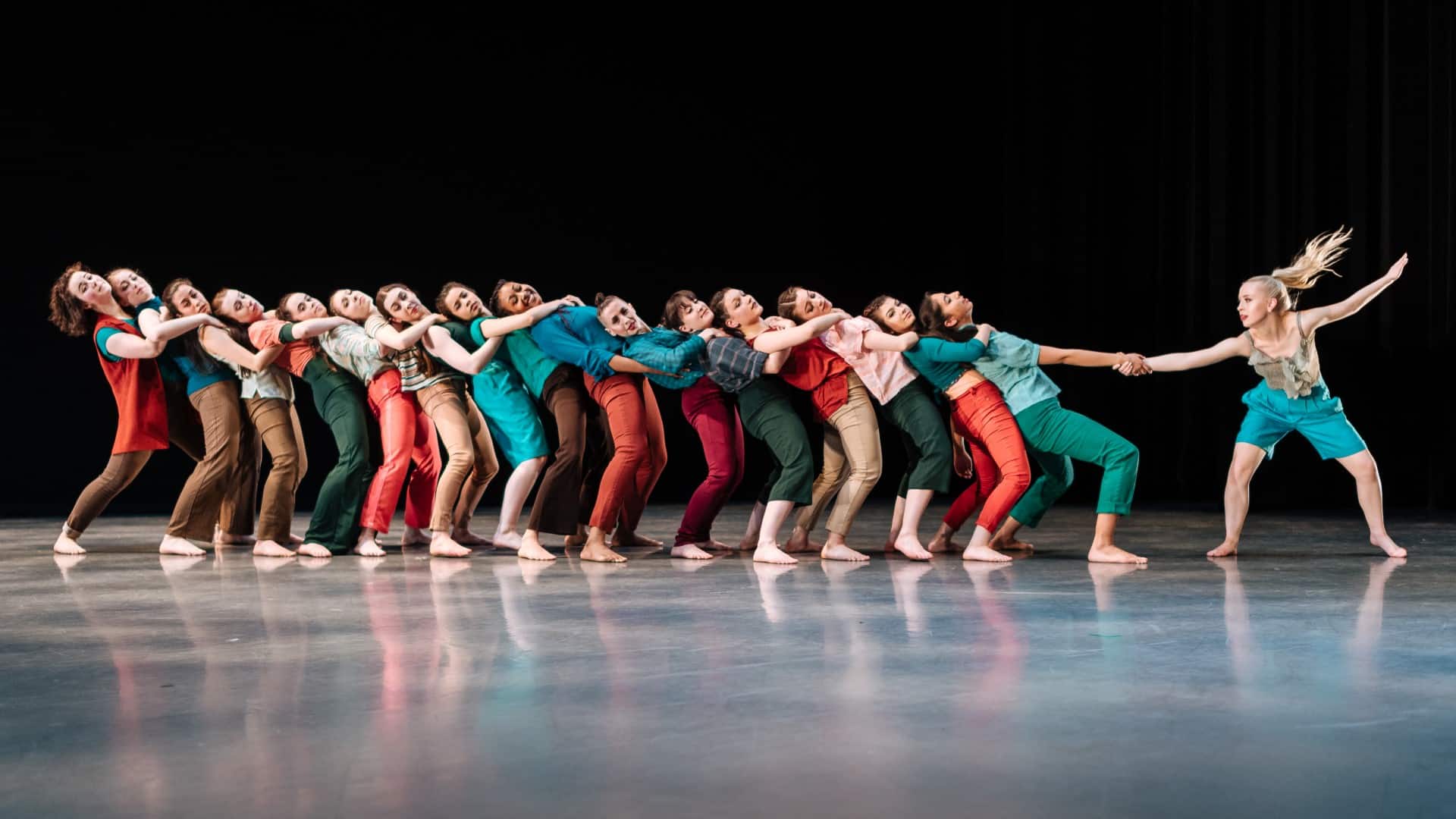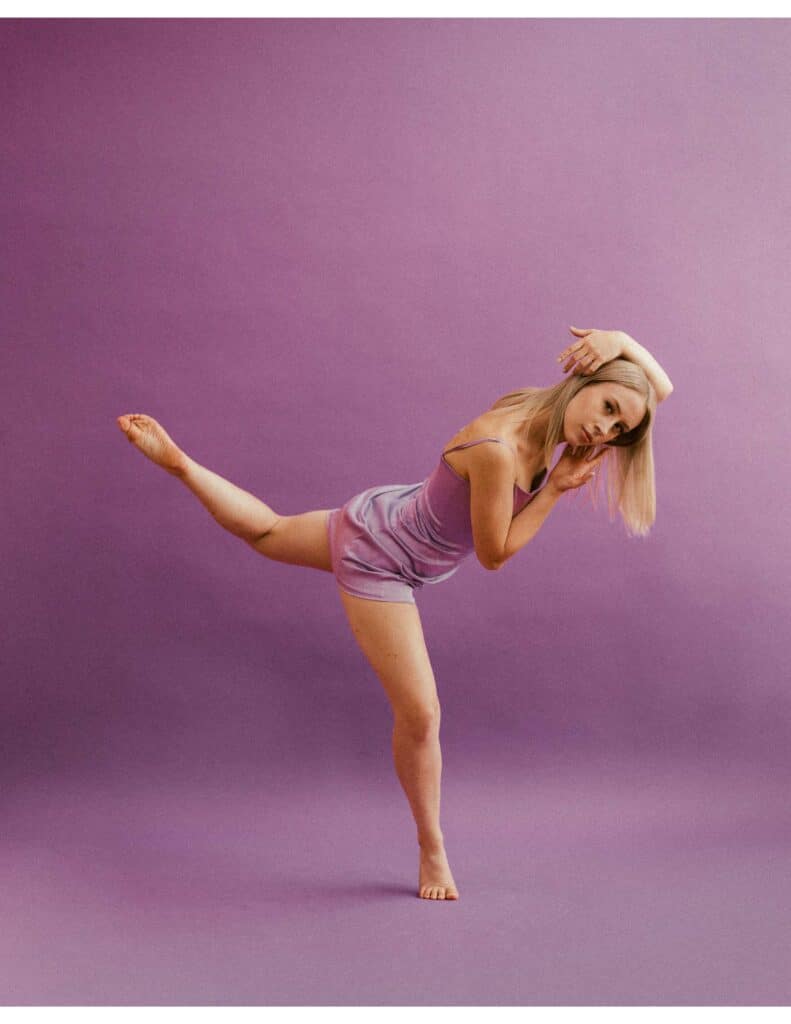What has your career been like, so far, after graduating?
My career since graduating from George Brown Dance (GBD) has been quite varied and includes performing, choreographing, and teaching. Soon after graduation I was offered a position as a Rehearsal Director for Local Participants in Ballet Jörgen’s The Nutcracker: A Canadian Tradition. This position really made use of the skills I had learned in repertoire classes at GBD because I had to study Bengt Jörgen’s choreography and then teach it to the young dancers who would be performing on stage with the Ballet Jörgen company members. I also began working as a pointe shoe fitter at The Shoe Room in Toronto, the official store of Canada’s National Ballet School.
I’m very grateful to have had the opportunity to choreograph for GBD’s Ensemble in 2018 and 2019, which was something I had the goal of doing while I was a student there. In 2018, I set a piece on 14 dancers titled Multiverse which was an experiment in exploring alternate universes through movement and what our physicality might be like on other planets. In 2019, I worked with 7 dancers and choreographed Slack Jaw which was about how depression affects our ability to connect with others.
During these years I also was a member of The Garage; a collective of Toronto contemporary dancers exchanging ideas and creating new works. The Garage was originally founded by Jörgen Dance’s Choreographer in Residence and acclaimed choreographer Hanna Kiel.
Two years after graduating I found myself wanting to have the experience of dancing in another country and I was eager to learn more about modern dance disciplines. This led to relocating in 2021 to New York City where I danced for a year in The Ailey School’s Independent Study Program. In 2022, I completed my studies at The Ailey School and began my career in NYC which, you can imagine, was a very exciting achievement for me! I began working with VashtiDance Theater, a NYC based company known for creating works of historical and socially relevant themes that have been performed at venues across the United States, abroad and a performance for the International Association of Blacks in Dance (2022) in at the Sheraton Centre in Toronto. More recently, in June of this past year, we performed an evening of works celebrating the great Nina Simone at the Billie Holiday Theater in Brooklyn. The piece by VashtiDance Theater was set to one of her most famous songs, Sinnerman and blended disciplines of modern and West African Dance, styles of dance which I particularly enjoy performing.
Also, in June I was selected to present my new self-choreographed contemporary solo Thousand Eyes at Uptown Rising which is a festival showcase that provides choreographers with the opportunity to present their new works and experiment with their artistry. Aside from these recent performances, I am also honored to be a ballet teaching assistant for The Ailey School’s Junior Division.
How do you feel George Brown Dance prepared you for your future, working professionally, in dance?
George Brown Dance had a profound role in shaping my artistry as a dancer and choreographer. I developed a strong identity as an artist which is one of the most important qualities one needs for a career in dance because it sets you apart from other artists and provides you more confidence in expressing your artistry.
I’m so grateful that dance composition was a part of our training, as it helped me find my voice as a choreographer. Our teacher, Hanna Kiel, challenged us to get creative in ways that were personal to us and to think beyond our preconceived ideas of how to choreograph. This gave me a sense of creative agency and left me feeling capable of creating any kind of work I desired.
Working with distinguished choreographers like Susie Burpee and Nicola Pantin on developing new works for GBD’s Unleashed performances was a special experience because they were interested in what we brought to the artistic process as individuals and our contributions were incorporated into the finished work. For example, Susie had us create short choreographic phrases and she would choose the most unique movement from each of our phrases to make something new. She assembled those movements into a phrase that fit the narrative of her piece, titled Fifteen Minutes of Feminism which touched on female unity, sisterhood, and motherhood.
George Brown Dance is fantastic at nurturing an individual’s unique sense of artistry which I have found most important in my professional success as a performing artist.

Would you recommend George Brown Dance to other aspiring professional dancers and why?
I would absolutely recommend George Brown Dance to other dancers who want to have rewarding careers and become seasoned artists. The biggest reason I recommend this program to other dancers is because of how outstanding and nurturing the faculty is. Every teacher I worked with shared valuable insights about dance and life with us. In addition to their great teaching, I genuinely felt that they cared about their students mental and physical health and our success in our future careers as dancers, choreographers, actors, singers, and teachers. Another highlight about the programs is the amount and variety of dancing within your days. I would have 4 dance classes a day, all different styles and then rehearsals as well! You will be in amazing physical shape if you study at GBD. I really appreciated that the curriculum included voice and acting classes as these are skills that broaden your possibilities as a dancer and performer.
Given the fact that I grew up in Red Deer, Alberta, I always thought of Toronto as a huge city. I wasn’t prepared for the size difference between Toronto and NYC. The auditions in NYC are abundant and packed with dancers. Despite the size difference between the two cities, something they have in common is you begin to see many of the same people at auditions. There is a community that you get to know over time, and I love connecting with this community of artists through our shared experiences. Since NYC is so huge it feels particularly special to have found a lovely group of like-minded artists.
I would certainly say that I am excited about the number of choreographic opportunities to be had in the city. After creating and performing my new solo Thousand Eyes at Uptown Rising this year, I’m eager to present my work at more festivals and venues. As my network here expands, I am also looking forward to choreographing on other dancers in the future. Most of my works I’ve created so far have been contemporary in style, so I want to challenge myself to create a jazz piece.
I’m excited and astounded by the variety of possibilities for dancers here that I have never considered before. I’m so grateful for the opportunity to do something that wasn’t initially on my radar. I hope to be surprised by more opportunities like this in the future!
As a choreographer my initial inspiration usually comes from a piece of music. I don’t always end up using that piece of music in the completed work, but it serves as a starting point and impetus for movement and the concept of the piece. The music’s personality influences my decision on what I want my choreography to say, and I typically choose music that I can relate to in some way. Once I have a musical inspiration that aligns with a theme I want to express, I start to create movement that will portray that theme.
I often see movement or pictures in my mind when I hear the music I want to use and then I do my best to recreate it on myself or other dancers. Sometimes I create movement independent from the influence of any music. To do this I think about how bodies would appear or move in ways that are relevant to emotions or themes I want to express with the choreography. Once I have gestures, pictures, or movements that represent what I want to say, I weave them into choreographic phrases by adding level changes, repetitions, transitions, and travel patterns.
As the piece is coming together, I make sure it conveys the story and theme accurately to audience members by considering what people may interpret from not knowing the intention I created with.
Two of my modern teachers I had during my program, Kathleen Rea and Tina Fushell, stressed the importance of networking to get opportunities in our career. We were taught to learn who we were interested in working with by getting involved with the dance community and going to as many shows as possible. With so many great artists in both Toronto and NYC it’s incredibly important to know what you want to do and seek out opportunities to be in the studio with people you want to work with. It can be intimidating to introduce yourself to industry professionals, but I’ve learned it’s a skill that needs to be practiced, just like dancing. Being able to connect with people and having the courage to start a conversation is something I’ve gotten better at over time. It’s very rewarding to see how it has positively impacted my career!
Another important lesson which was given to us by Derek Sangster, George Brown Dance program director and jazz teacher, was to not shrink yourself down in environments where you may be uncomfortable such as an audition or working with a new choreographer. We were taught to present ourselves and dance with confidence no matter what because no one will see your dancing if you always place yourself in the back of the room!
Keep up with George Brown Dance on Instagram and Facebook for updates on programs, auditions and more! Follow Madi @madi.gibson to see what she does next!

